
The TGV is France's intercity high-speed rail service, operated mainly by SNCF. SNCF worked on a high-speed rail network from 1966 to 1974 and presented the project to President Georges Pompidou who approved it. Originally designed as turbotrains to be powered by gas turbines, TGV prototypes evolved into electric trains with the 1973 oil crisis. In 1976 the SNCF ordered 87 high-speed trains from Alstom. Following the inaugural service between Paris and Lyon in 1981 on the LGV Sud-Est, the network, centered on Paris, has expanded to connect major cities across France and in neighbouring countries on a combination of high-speed and conventional lines. The TGV network in France carries about 110 million passengers a year.

The TGV Atlantique (TGV-A) is a class of high-speed trains used in France by SNCF; they were built by Alstom between 1988 and 1992, and were the second generation of TGV trains, following on from the TGV Sud-Est trainsets. The trains were named after the Ligne à Grande Vitesse Atlantique that they were originally built for.

The SNCF TGV Réseau (TGV-R) is a TGV train built by Alstom between 1992 and 1996 for SNCF, the French national railway for use on high-speed TGV services. The Réseau trainsets are based on the earlier TGV Atlantique. The first Réseau sets entered service in 1993.
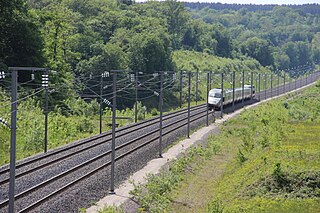
The Ligne à Grande Vitesse Est européenne, typically shortened to LGV Est, is a French high-speed rail line that connects Vaires-sur-Marne and Vendenheim. The line halved the travel time between Paris and Strasbourg and provides fast services between Paris and the principal cities of Eastern France as well as Luxembourg and Germany. The LGV Est is a segment of the Main Line for Europe project to connect Paris with Budapest with high-speed rail service.
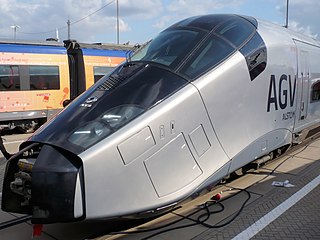
The AGV is a standard gauge, high-speed, electric multiple-unit train designed and built by Alstom.

The SNCF TGV Sud-Est was a French high speed TGV train built by Alstom and Francorail-MTE and operated by SNCF, the French national railway company. A total of 111 trainsets were built between 1978 and 1988 for the first TGV service in France between Paris and Lyon which opened in 1981. The trainsets were semi-permanently coupled, consisting of two power cars (locomotives) and eight articulated passenger carriages, ten in the case of the tri-voltage sets. The trains were named after the Ligne à Grande Vitesse Sud-Est that they first operated on. They were also referred to as TGV-PSE, an abbreviation of Paris Sud-Est.

The LGV Sud-Est is a French high-speed rail line which connects the Paris and Lyon areas. It was France's first high-speed rail line. The inauguration of the first section between Saint-Florentin and Sathonay-Camp by President François Mitterrand on 22 September 1981 marked the beginning of the re-invigoration of French passenger rail service.

Thalys PBKA is a high-speed trainset, manufactured by the French company GEC-Alsthom, and used on the international Eurostar service. Originally built for Thalys they were intended to operate between Paris, Brussels, Köln and Amsterdam, forming the abbreviation PBKA. They were initially intended to be sole rolling stock of the service, but their extreme cost and complexity due to their quadri-current capability led the order of a simpler tri-current sister class, the Thalys PBA, a TGV Réseau derivative, with which they can work in multiple.

The TGV Duplex is a French high-speed train of the TGV family, manufactured by Alstom, and operated by the French national railway company SNCF. They were the first TGV trainsets to use bi-level passenger carriages with a seating capacity of 508 passengers, increasing capacity on busy high-speed lines. While the TGV Duplex started as a small component of the TGV fleet, it has become one of the system's workhorses.
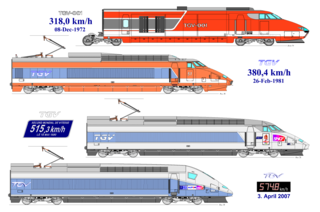
The TGV holds a series of land speed records for rail vehicles achieved by SNCF, the French national railway, and its industrial partners. The high-speed trials are intended to expand the limits of high-speed rail technology, increasing speed and comfort without compromising safety.

TGV Lyria is the brand name used for TGV railway lines connecting France and Switzerland. Lyria is also a corporation that runs the service using the staff of the SNCF in France and Swiss Federal Railways (SBB CFF FFS) in Switzerland – the staff consists of one French and one Swiss train manager on the whole journey.

Operation V150, where 150 refers to a target speed in metres per second, was a series of high-speed trials carried out on the LGV Est. The V150 was a specially configured TGV high-speed train notable for breaking the world railway speed record on 3 April 2007. The train was built in France and reached a speed of 574.8 kilometres per hour (357.2 mph) on an unopened section of the LGV Est between Strasbourg and Paris, in France topping the previous record of 515.3 kilometres per hour (320.2 mph) set in 1990.

The Renfe Class 100 is a high-speed train used for AVE services by the Renfe Operadora, in Spain. It was the first high-speed train put into service in Spain, in 1992.

The KTX-I, also known as the TGV-K or Korail Class 100000, is a South Korean high speed train class based on the French TGV Réseau. The 20-car formation of the trainsets without restaurant car is optimized for high capacity. The 46 trainsets were built partly in France and partly in South Korea in the framework of a technology transfer agreement, which was the basis for further domestic high-speed train development in South Korea.

France has a large network of high-speed rail lines. As of June 2021, the French high-speed rail network comprises 2,800 km (1,740 mi) of tracks, making it one of the largest in Europe and the world. As of early 2023, new lines are being constructed or planned. The first French high-speed railway, the LGV Sud-Est, linking the suburbs of Paris and Lyon, opened in 1981 and was at that time the only high-speed rail line in Europe.
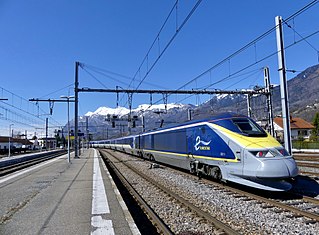
The British Rail Class 373, known in France as the TGV TMST and branded by Eurostar as the Eurostar e300, is a French designed and Anglo-French built electric multiple unit train that was used for Eurostar international high-speed rail services from the United Kingdom to France and Belgium through the Channel Tunnel. Part of the TGV family, it was built with a smaller cross-section to fit the smaller loading gauge in Britain, was originally capable of operating on the UK third rail network, and has extensive fireproofing in case of fire in the tunnel. It is both the second longest—387 metres —and second fastest train in regular UK passenger service, operating at speeds of up to 300 kilometres per hour (186 mph).
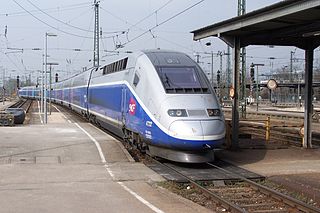
Avelia Euroduplex, more commonly known as just Euroduplex or TGV 2N2 in France, is a high-speed double-decker train manufactured by Alstom. It is primarily operated by the French national railway company SNCF, and also in operation with the Moroccan national railway company ONCF. It is the 3rd generation of the TGV Duplex.

The TGV M is a high-speed passenger train designed and produced by Alstom. It has a broadly similar design to the TGV Duplex sets, with bi-level carriages and a push–pull configuration with a power car on either end. However, it is more energy efficient and provides lower operating costs.

The first-generation Acela Express trainset is a unique set of vehicles used on the Acela, Amtrak's flagship high-speed service along the Northeast Corridor (NEC) in the Northeastern United States. When they debuted in 2000, the sets were the fastest in the Americas, reaching 150 mph (240 km/h) on 33.9 mi (54.6 km) of the route. They were built between 1998 and 2001 by a consortium of Alstom and Bombardier. Each set has two power cars derived from units that Alstom built for the TGV, and six passenger cars derived from the LRC that Bombardier built for Via Rail.





















